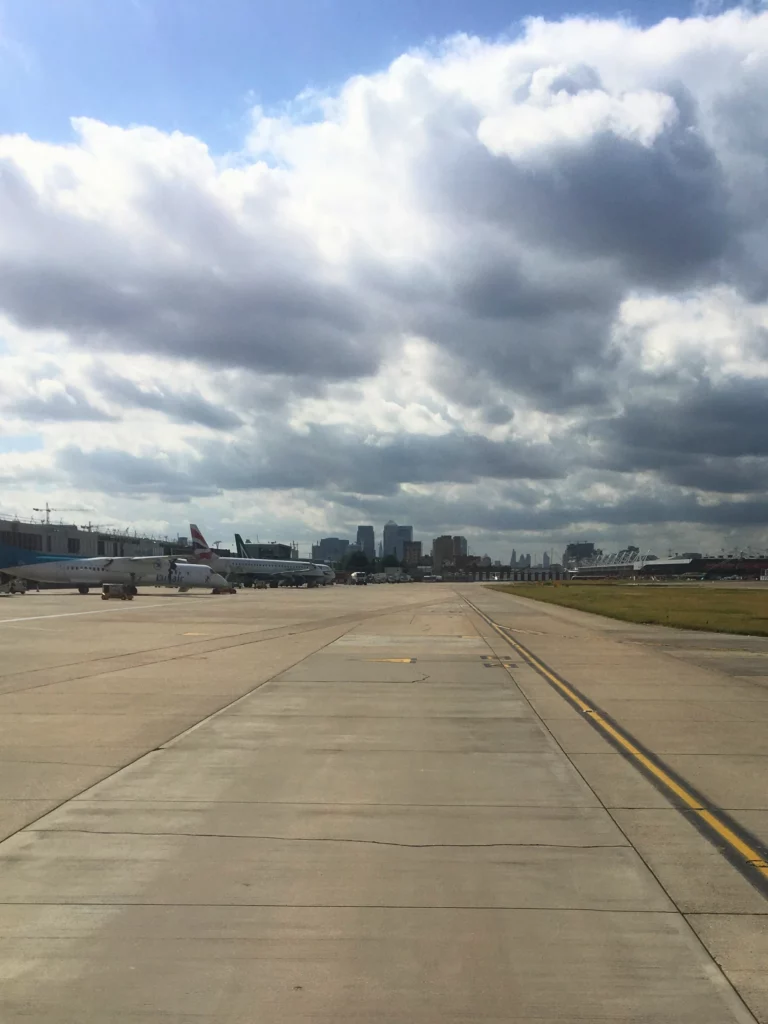
Airports are among the most complex and high-risk environments to manage, where safety, operational continuity, and environmental protection must work hand in hand. While much attention is rightly given to aircraft safety and passenger welfare, a less visible but equally critical risk lies beneath our feet: the potential for contaminated firewater runoff during emergency incidents.
Fires, whether in terminals, car parks, or utility infrastructure, generate large volumes of firefighting water that rapidly become polluted with fuels, chemicals, debris, and hazardous substances. If left unchecked, this firewater can swiftly enter drainage systems, rivers, and groundwater supplies, causing extensive environmental damage and legal liabilities.
Recent incidents, such as the substation fire adjacent to London Heathrow Airport and the devastating car park blaze at Luton Airport, have highlighted the importance of rapid containment measures.
In this blog post, we’re going to explore the environmental challenges posed by firewater runoff, examine how drain closure devices play a vital role in containment efforts, and outline best practices for airport environmental managers striving to protect both infrastructure and the environment.
Understanding the Environmental Challenge: Firewater Runoff
When a fire breaks out at an airport, the immediate focus is rightly on preserving life and safeguarding critical infrastructure. However, the environmental consequences of firefighting activities are often less visible but no less severe. Firewater runoff (the water used to extinguish fires, mixed with contaminants) can pose a significant environmental threat if not properly contained.
During an incident, firewater quickly becomes laden with a cocktail of pollutants. These may include:
- Hydrocarbons from fuel spills
- Heavy metals from burning vehicles and building materials
- PFAS (per- and polyfluoroalkyl substances) from firefighting foams
- Debris and microplastics from structural damage
- Toxic byproducts formed through combustion.
If this polluted water is allowed to enter surface water systems, such as streams, rivers, or local drainage networks, it can have devastating impacts. Aquatic life may be harmed or killed, water supplies contaminated, and soil quality degraded. Moreover, pollutants can persist in the environment for decades, causing long-term ecological damage.
From a regulatory standpoint, uncontrolled discharge of contaminated firewater is a serious breach of environmental law in the UK. Offenders risk substantial fines under legislation such as the Environmental Protection Act 1990 and the Water Resources Act 1991, alongside potential reputational damage that can impact airport operations and stakeholder trust. Given these risks, it is crucial that airports have systems in place to prevent polluted firewater from escaping into the wider environment. This is where drain closure devices come into their own, offering an effective and immediate means of protecting sensitive drainage points during emergencies.

Real-World Incidents
1. Heathrow Airport – Substation Fire (2025)
In March 2025, a major fire erupted at an electrical substation near London Heathrow Airport following an uncontrolled release and subsequent ignition of approximately 25,000 litres of cooling oil. The power outage forced a temporary closure of the UK’s busiest airport, which did not have backup power available immediately. Thousands of flights were cancelled or diverted, causing severe disruption to travellers worldwide and an estimated economic impact of over £30 million per day in lost revenues, passenger compensation, and logistical costs.
Beyond the operational chaos, the incident brought serious environmental risks to the fore. Electrical substations contain large volumes of oil-filled transformers and chemical-laden equipment; when exposed to fire, these can release highly toxic substances into the environment. Firefighting efforts, while essential to control the blaze, can generate large quantities of contaminated firewater, raising urgent concerns about potential pollution of local drainage networks and watercourses. The official report into the fire has yet to be published at the time of writing.
It is not known whether drain closure devices were activated at the substation; however, without rapid and effective containment, there would have been a real danger of hazardous substances entering the environment, breaching environmental regulations, and compounding the crisis.
2. Luton Airport – Car Park Fire
In October 2023, Luton Airport was the scene of a catastrophic fire that destroyed a multi-storey car park and caused extensive damage to over 1,400 vehicles. The intensity and scale of the blaze posed enormous challenges for emergency responders.
As hundreds of vehicles burned simultaneously, the resultant firewater became heavily contaminated with petrol, diesel, oils, melted plastics, and particulate matter. The volume of water used to battle the inferno added to the risk of this toxic runoff overwhelming the airport’s drainage infrastructure.
There was a real danger that contaminated firewater would have infiltrated nearby groundwater supplies or flowed into adjacent natural watercourses, causing widespread pollution. In such high-pressure situations, automated or remotely triggered drain closure systems could mean the difference between containment and a full-scale environmental crisis.
There was a huge clean-up effort required after the car park fire, with the airport team employing specialist environmental consultants to oversee the operation, including groundwater and soil samples to test for contamination.

The Importance of Drain Closure Devices
Drain closure systems serve as a vital final barrier in your site’s environmental protection strategy, swiftly sealing drainage points in the event of a spillage or firewater incident. Acting as tertiary containment, they are designed to trap pollutants within the internal drainage network before they can escape into the wider environment.
These systems allow for the targeted or complete isolation of site drainage infrastructure. Depending on the configuration selected, many models include automated monitoring, built-in self-diagnostics, and comprehensive reporting features, giving site teams clear visibility over system performance and readiness.
A range of detection equipment can be integrated into your system, such as pH sensors, level alarms, and detectors for oil, turbidity, or glycol contamination. Drain closure systems can be configured for automatic activation via environmental sensors, a fire alarm, your building management system, or a remote device.

For large or dispersed sites, such as airports where an incident may occur some distance from the control room, automated activation is essential. It eliminates the reliance on manual intervention and ensures that drains are sealed within seconds to contain potential pollutants effectively.
The benefits of drain closure systems include:
- Immediate containment of firewater at the source
- Allows time for safe disposal or treatment of contaminated water
- Protects critical infrastructure and natural water bodies
- Supports compliance with environmental regulations such as the Environmental Protection Act 1990, Water Resources Act 1991 and CIRIA C736.
Aquasentry has supplied and installed drain closure devices at airports around Europe, including Birmingham Airport, Liverpool John Lennon Airport, London Heathrow Airport, London Luton Airport and Gibraltar.

Best Practices for Implementing Drain Closure Systems at Airports
To maximise the effectiveness of drain closure systems and ensure environmental compliance, airports should follow a set of proven best practices:
Risk assessment
Begin by conducting a thorough assessment of the airport’s drainage infrastructure to identify vulnerable or high-risk discharge points. These may include locations near fuel storage, car parks, maintenance hangars, and critical utility buildings. Understanding where firewater or chemical spills are most likely to occur allows for the targeted deployment of drain closure systems.
You must also consider the location of Automatic Water Suppression Systems (AWSS). The review into the Luton Airport carpark fire writes that the Bedfordshire Chief Fire Officer has strongly recommended AWSS “be included in the design of any new or replacement [multistorey car parks] and that serious consideration be given to retrofitting AWSS in its other existing [multistorey car parks].” Sprinkler systems in a car park that are activated upon detection of a fire would also necessitate the closure of the drainage system to prevent contaminated firewater from being discharged into the environment.
Routine maintenance and testing
Drain closure devices must be maintained and tested regularly to guarantee functionality during an emergency. This includes scheduled inspections, operational checks, and simulated activations. A device that fails to operate when needed can render the entire containment strategy ineffective.
Integration with emergency response plans
Drain closure systems should be embedded within the airport’s wider emergency response framework. Whether the incident involves fire, chemical leaks, or fuel spills, clear protocols must outline when and how to trigger the system — and who is responsible for oversight during a response.
Staff training and preparedness
Facilities and environmental teams must be properly trained in the operation of drain closure devices, including both manual and automated activation methods. Refresher training and drills ensure staff can respond quickly and confidently under pressure. Build the drain closure training into the regular multi-agency training exercises that should be taking place to improve coordination during large-scale incidents.
Smart systems and automation
Where possible, consider integrating advanced features such as environmental sensors, automated triggers, and remote-control capabilities. For large, complex airport sites, automated drain closure significantly reduces response time and removes the dependence on manual intervention, helping to contain pollutants within seconds of detection.
Conclusion
As recent incidents at UK airports have demonstrated, environmental protection cannot be an afterthought in emergency planning — it must be embedded into the very fabric of airport operations. Firewater runoff poses a serious and often under-recognised threat, with the potential to cause long-lasting damage to ecosystems, water supplies, and organisational reputations.
Drain closure systems offer a practical, effective, and increasingly essential line of defence. When integrated with smart monitoring, rapid-response protocols, and robust training, these systems can prevent pollutants from escaping into the environment, supporting both legal compliance and corporate responsibility.
For airport management, the message is this: proactive investment in drain closure technologies and best practices is not only a safeguard against environmental harm — it’s a strategic decision that protects infrastructure, operations, and public trust.
Sign up for the latest news and offers


